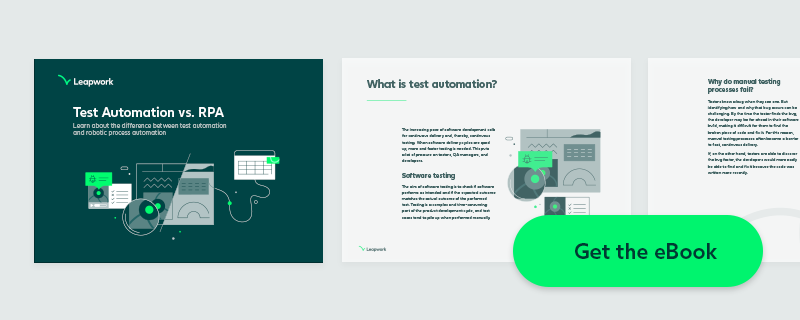5 Differences Between Test Automation and RPA
Test automation and Robotic Process Automation (RPA) are similar in some ways. Both disciplines are about automating processes that are repetitive, costly, time-consuming, and error-prone. However, there are significant differences between the two.
When automating different types of tasks, people usually refer to RPA or test automation depending on the given task. Some companies purely perform one of them, while others use both and even perform tasks that could be argued to belong to both disciplines.
So what's the difference between the two? Find out in this blog post.
1. Software development owns test automation, any department can own RPA
The first differences between test automation and RPA is which department owns the automation. Test automation is used in software development and is usually owned by a limited set of users in the quality assurance team. These are the people in charge of running test cases to ensure quality in specific software applications.
RPA, on the other hand, can be owned by a wider set of departments. Sometimes ownership is centralized, but often, ownership lies in the hands of any department that might want to automate a repetitive and error-prone business process.
2. RPA is about completing processes, test automation is about checking them
Both test automation and RPA are implemented to increase the efficiency and quality of certain interactions between a human and a computer.
RPA is used to automate sequences of tasks in a clearly defined path to successfully execute a process that will allow you to complete your work faster while reducing human error. Test automation is used to conduct test cases to see where an application fails, so that QA can assess quality and risk before a release.
This means that when you create an automation flow in test automation, you expect the flow to either pass or fail. If it fails, you would flag the given flow and move on to the next. However, in RPA, you create a flow with the expectation that it will pass – or work as intended – and if it doesn’t, you should take immediate action to resolve the issue.
Therefore, in test automation, failures provide insight on business risk while in RPA they become an obstacle towards successful task completion.
3. The nature of test automation is to involve a single application, RPA involves several
Another difference between test automation and RPA is the System Under Automation (SUA). Test automation cases are usually applied to a single application, software, or product in different environments, whereas RPA flows typically run across multiple applications simultaneously.
Moreover, RPA is usually implemented in applications that rarely change while test automation is used in applications that are typically incomplete or evolving. Therefore, test automation delivers coverage while RPA focuses on doing the same sequence over and over again.
For example, if you are a software company, the software you sell to your clients is considered your product. You would use test automation to test that your product has no bugs and that all features are working as intended before a release. However, you can also apply RPA to other business processes within your finance or HR departments. These business processes might involve different applications, such as Salesforce, Oracle, or Dynamics365.
4. Test automation requires domain knowledge, RPA requires process knowledge
In conventional test automation, the tester or QA analyst must have thorough domain knowledge of the functionality of the application under test. This knowledge is needed to define the test scenarios that will then serve as the basis for automation.
In RPA, users must have strong knowledge of the process to be automated. However, they do not need in-depth knowledge of the inner working of the applications that will be used to complete that process.
5. Traditionally, test automation required programming knowledge, RPA did not
Most RPA tools allow users to automate through a visual user interface that is intuitive in nature. Test automation tools, on the other hand, have traditionally required coding skills to operate. This has changed in recent years, and now more and more test automation tools provide codeless automation to allow easier collaboration in quality assurance teams.
In sum, the 5 differences between test automation and RPA are:
- Ownership
- Purpose
- Scope
- Domain knowledge
- Programming knowledge
Learn more about test automation and RPA in our eBook:

